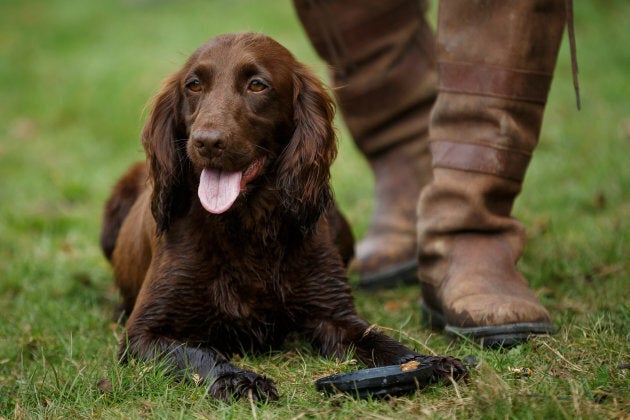Why Should We Use Animals For Labor?
This article exists as part of the online archive for HuffPost Canada, which closed in 2021.
Dexter, an emotional support peacock, made global headlines recently when United Airlines refused to allow him on a flight. His story is the latest to reanimate public word about the certification and regulation of service animals, and the rights of people with disabilities. But this unusual situation is also an opportunity to reflect on the work we requite to animals, which species nosotros employ and what our responsibilities are to them.
We have long used animals' labour, and few communities in Canada would have been built without horses' strength, power and co-operation. Much similar people, today's animals are less likely to be used for manual labour, and are more frequently employed in interactive, caring and service work. They also help with police enforcement, and even sniff out endangered species, smuggled appurtenances and insect infestations.
Service animals are normally paired with a human and engaged in total-time, circular-the-clock labour. They may physically guide someone, assistance with daily tasks or monitor the person'south physical and emotional country, then respond with a warning, an intervention or calming touch.

Ben Queenborough via Getty Images
Therapy animals commonly work part-time, and either are visited at intendance farms or are transported to long-term care homes, schools, libraries and detention centres to participate in a range of programs and interactions. In Canada, we also now have institutional or facility dogs who condolement and support child witnesses as they participate in court cases.
Animals — whether they are dogs, horses, chickens, or rats — are using an intricate combination of their concrete, intellectual and emotional abilities in their work for us. Rats, for example, are now employed in a range of means, including for detecting land mines and forewarning people of seizures.
Bookish enquiry is offset to reveal the depth and breadth of the cognitive skills, emotional lives and cultural practices of animals of all sizes. When working for us, various species engage in nuanced advice, control or suppress their feelings in club to behave accordingly, and actively assess people and complex environments.
In most cases, especially when we entrust animals with caring for united states of america, nosotros have evolved beyond seeing them simply as beasts of burden. We are more likely to recognize the active roles animals play and the choices they brand, seeing them as subjects, not simply objects. Yet well-nigh animals are still legally positioned as property, and their work-lives are ultimately governed by humans. As a event, nosotros have significant responsibilities.
Not all species or individual animals want to work for us, and we ought to recognize this fact.
The largest group of vertebrate animals in Canada — the 700 one thousand thousand who live brusk, difficult lives, and then are killed to exist consumed as food — is an elephant in the room, and so to speak. We could view the required and repeated physical product of babies, milk and eggs as a kind of bodily piece of work. Whether we see farmed animals every bit working or non, there are crucial discussions nigh their weather condition taking identify, and about whether we should be using animals in this way at all, especially given the expansion of plant-based foods and drinks, and lab-grown "clean meat."
Not all species or individual animals want to piece of work for u.s., and nosotros ought to recognize this fact. Work should be about collaboration, not coercion. If some animals are going to work with and for usa, we should only offer them humane jobs, and pay conscientious attention to their work-lives in a total sense. This includes their hours of work, leisure and social opportunities, and their lives afterward their formal jobs have ended. We must prioritize not only animals' physical health, simply also their psychological well-being.
Conspicuously the world of work is changing for people and animals alike, and information technology is challenging our conventional ideas and approaches. As a result, we ought to harness the potential of solidarity and reciprocity in our relationships, likewise as in our political arenas.
As a outset, we should strengthen and expand our antiquated fauna cruelty laws, and properly fund their enforcement. But nosotros too need to create new policies and programs that reflect and genuinely respect the diverse realities of animals' labour, interests and lives. In other words, it's fourth dimension nosotros exercise more political work for the animals who practice and so much for us.
Pop in the Community
This article exists as role of the online archive for HuffPost Canada. Certain site features have been disabled. If you accept questions or concerns, please check our FAQ or contact support@huffpost.com.
Source: https://www.huffpost.com/archive/ca/entry/animal-labour-workers_a_23371350
Posted by: sherrellsiondonsen.blogspot.com

0 Response to "Why Should We Use Animals For Labor?"
Post a Comment